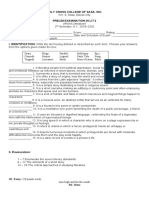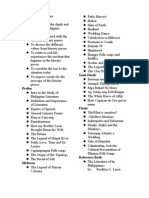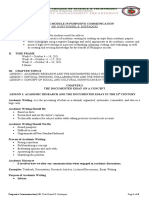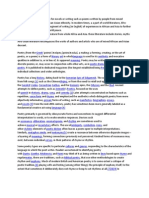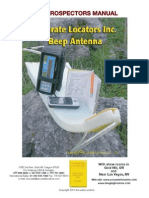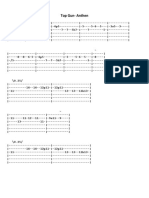100%(1)100% found this document useful (1 vote)
224 viewsAfro-Asian Literature: Hymns That Formed The Cornerstone of Aryan Culture
Afro-Asian Literature: Hymns That Formed The Cornerstone of Aryan Culture
Uploaded by
Miyuki Nakata1) Afro-Asian literature encompasses works from people with both African and Asian heritage, reflecting their shared cultures. It includes early Vedic texts from India as well as later epics like the Mahabharata and Ramayana.
2) During the Classical period in India, Sanskrit became the main literary language and important works included fables in the Panchatantra and Kalidasa's drama Sakuntala.
3) Modern Indian authors writing in this genre include Premchand, who pioneered adapting Western styles, and Kamala Markandaya, who addressed clashes between traditional and modern values.
Copyright:
© All Rights Reserved
Available Formats
Download as DOCX, PDF, TXT or read online from Scribd
Afro-Asian Literature: Hymns That Formed The Cornerstone of Aryan Culture
Afro-Asian Literature: Hymns That Formed The Cornerstone of Aryan Culture
Uploaded by
Miyuki Nakata100%(1)100% found this document useful (1 vote)
224 views5 pages1) Afro-Asian literature encompasses works from people with both African and Asian heritage, reflecting their shared cultures. It includes early Vedic texts from India as well as later epics like the Mahabharata and Ramayana.
2) During the Classical period in India, Sanskrit became the main literary language and important works included fables in the Panchatantra and Kalidasa's drama Sakuntala.
3) Modern Indian authors writing in this genre include Premchand, who pioneered adapting Western styles, and Kamala Markandaya, who addressed clashes between traditional and modern values.
Original Description:
afro asian reviewer
Original Title
Afro asian
Copyright
© © All Rights Reserved
Available Formats
DOCX, PDF, TXT or read online from Scribd
Share this document
Did you find this document useful?
Is this content inappropriate?
1) Afro-Asian literature encompasses works from people with both African and Asian heritage, reflecting their shared cultures. It includes early Vedic texts from India as well as later epics like the Mahabharata and Ramayana.
2) During the Classical period in India, Sanskrit became the main literary language and important works included fables in the Panchatantra and Kalidasa's drama Sakuntala.
3) Modern Indian authors writing in this genre include Premchand, who pioneered adapting Western styles, and Kamala Markandaya, who addressed clashes between traditional and modern values.
Copyright:
© All Rights Reserved
Available Formats
Download as DOCX, PDF, TXT or read online from Scribd
Download as docx, pdf, or txt
100%(1)100% found this document useful (1 vote)
224 views5 pagesAfro-Asian Literature: Hymns That Formed The Cornerstone of Aryan Culture
Afro-Asian Literature: Hymns That Formed The Cornerstone of Aryan Culture
Uploaded by
Miyuki Nakata1) Afro-Asian literature encompasses works from people with both African and Asian heritage, reflecting their shared cultures. It includes early Vedic texts from India as well as later epics like the Mahabharata and Ramayana.
2) During the Classical period in India, Sanskrit became the main literary language and important works included fables in the Panchatantra and Kalidasa's drama Sakuntala.
3) Modern Indian authors writing in this genre include Premchand, who pioneered adapting Western styles, and Kamala Markandaya, who addressed clashes between traditional and modern values.
Copyright:
© All Rights Reserved
Available Formats
Download as DOCX, PDF, TXT or read online from Scribd
Download as docx, pdf, or txt
You are on page 1of 5
AFRO-ASIAN LITERATURE a. VERDIC PERIOD (1500 B.C – 500 B.
C) between two groups of cousins, the Kauravas and
Afro-Asian literature is literature that encompasses - This period is named for the Vedas, a set of the Pandavas set sometime 3102 BC.
the cultural and political world of people with both hymns that formed the cornerstone of Aryan • made up of almost 100,000 couplets divided into
African and Asian heritage. culture 18 parvans.
The term was coined around 1950 to 1955 and -Hindus consider the Vedas, • Parvans also called as sections
relates to people who share the two cultures. VEDAS • Mahabharata is an exposition on dharma (codes
- which were transmitted orally by priests, to be the of conduct), including the proper conduct of a king,
In many island areas around the world, such as
most sacred of all literature for they believe these of a warrior, of a man living in times of calamity,
Cuba, there are people of both African and Asian
to have been revealed to humans directly by the and of a person seeking to attain emancipation
descent who have started families together and
gods. from rebirth.
are creating children of both cultures.
RIGVEDAS BHAGAVAD GITA
The Afro-Asian literature genre also includes
• which has come to mean “hymns of supreme • Meaning—The Blessed Lord’s Song
Asian characters that pop up in African American
sacred knowledge,” • It is regarded by the Hindus in somewhat the
literature and African American characters that
• foremost collection or Samhita made up of 1,028 same way as the Gospels are by Christians
pop up in Asian literature.
hymns. • It forms part of Book IV and is written in the form
Afro-asian literature is the reflection of the storm • The oldest of the Vedas, it contains strong, of a dialogue between the warrior Prince
and stress of the developing nation seeking a energetic, non-speculative hymns, often Arjuna and his friend and charioteer, Krishna,
place under the sun comparable to the psalms in the Old Testament. who is also an earthly incarnation of the god
CHARACTERISTICS OF AFRO-ASIAN Vishnu.
LITERATURE b. EPIC & BUDDHIST AGE RAMAYANA
• There is often emphasis on the history, culture, • -refers to the late Vedic age, it is called epic age • was composed in Sanskrit, probably not before
and customs of a group of people when telling because it is the period of composition of the two 300 BC, by the poet Valmiki and consists of some
their stories. great epics, Mahabharata and the Ramayana. 24,000 couplets divided into seven books.
• Works were handed by mouth from generation
• This time was also the growth of later Vedic • It reflects the Hindu values and forms of social
to generation to entertain, educate and remind
literature, new Sanskrit literature, and Buddhist organization, the theory of karma, the ideals of
the people about their past, heroic deeds of their literature in Pali. wifehood, and feelings about caste, honor and
people, ancestry and culture. • The Dhammapada was also probably composed promises.
•
during this period.
INDIA • The Maurya Empire (322-230 B.C.) ruled by c. CLASSICAL PERIOD (A.D – 1000 A.D)
I. LITERATURE Ashoka promoted Buddhism and preached The main literary language of northern India during
THE INDUS VALLEY CIVILIZATION goodness, nonviolence, and ‘righteousness’ this period was Sanskrit, in contrast with the
-flourished in northern India between 2500 and 1500 although this period was known for warfare and Dravidian languages of southern India.
B.C. iron-fisted rule. Sanskrit, which means ‘perfect speech’ is
-an ancient civilization located in what is Pakistan and • The Gupta Dynasty (320-467 B.C.) was the next considered a sacred
northwest India today. great political power. During this time, language, the language spoken by the gods and
Hinduism reached a full flowering and was goddesses.
The Aryans evident in culture and the arts. PANCHANTRA
a group of nomadic warriors and herders, were the a collection of Indian beast fables originally written
earliest known migrants into India. They brought MAHABHARATA in Sanskrit.
with them a well-developed language and literature and • traditionally ascribed to the sage Vyasa It is intended as a textbook of artha (worldly
a set of religious beliefs. • consists of a mass of legendary and didactic wisdom); the aphorisms tend to glorify
material that tells of the struggle for supremacy
shrewdness and cleverness more than helping of • His sympathy for their poverty and backwardness ANITA DESAI
others. was later reflected in his works. • An English-language
SAKUNTALA PREM CHAND Indian novelist and author of
• a Sanskrit drama by Kalidasa, tells of the love • pseudonym of Dhanpat Rai Srivastava children’s books, she is
between Sakuntala and King Dushyanta • Indian author of numerous novels and short considered India’s premier
MRCCHAKATIKA stories in Hindi and Urdu who pioneered in imagist writer.
• The Little Clay Cart adapting Indian themes to Western literary styles. Major Works:
• is attributed to Shudraka, a king. Major Works: • Cry, the Peacock
• Sevasadana (House • Clear Light of Day
d. MEDIEVAL & MODERN AGE of Service) • Fire on the Mountain
(1000 A.D - PRESENT) • Manasarovar (The
Persian influence on literature was considerable Holy Lake)
during this period. Persian was the court language • Godan (The Gift of a VIR SINGH
of the Moslem rulers. Cow) • A Sikh writer and theologian,
he wrote at a time when Sikh
GITANJALI religion and politics and the
• Song Offerings was originally published in KAMALA MARKANDAYA Punjabi language were under
India in 1910 and its translation followed in • Her works concern the heavy attack by the English
1912. struggles of contemporary and Hindus.
THE TAJ MAHAL Indians with conflicting Major Work:
• a poem by Sahir Ludhianvi, is about the Eastern and Western values. • Kalghi Dhar Chamatkar- This novel is about the life
mausoleum in North India built by the Mogul Major Work: of the 17th century guru Gobind Singh.
emperor Shah Jahan for his wife Mumtaz- • Nectar in a Sieve- Her first
iMahal. novel and most popular work
ON LEARNING TO BE AN INDIAN
• an essay by Santha Rama Rau illustrates the
is about an Indian peasant’s
narrative of her difficult life.
CHINA
telling effects of colonization on the lives of the I. LITERATURE
people particularly the younger generation. R. K. NARAYAN Chinese literature reflects the political and social
• One of the finest Indian authors of his generation history of China and the impact of powerful
writing in English. religions that came from within and outside the
INDIA • His style is graceful, marked by genial humor, country.
elegance, and simplicity.
II. MAJOR WRITERS Major Work:
Its tradition goes back thousand of years and has
often been inspired by philosophical questions
KALIDASA • Swami and Friends- about the meaning of life, how to live ethically in
• a Sanskrit poet and dramatist His first novel is an society, and how to live in spiritual harmony with
is probably the greatest Indian episodic narrative the natural order of the universe.
writer of all time. recounting the
adventures of a group of
RABINDRANATH TAGORE schoolboys
• Tagore is a Bengali poet and CHINA
mystic who won the Nobel
Prize for Literature in 1913. II. MAJOR WRITERS
CHUANG TZU He wrote many poems speaking bitterly against the P'ang-huang (Hesitation)
was the most important early social and economic problems that were plaguing Yeh-ts'ao (Wild Grass)
interpreter of the philosophy China. Chao-hua hsi-shih (Morning Flowers Picked in
of Taoism. . Evening)
WORKS
LIEH TZU • Chang hen ge ("Song of Everlasting Sorrow")
was a Taoist teacher who
had many philosophical
which tells the story of Yang Guifei
• Songs of the Land of Ch'in
JAPAN
differences with his • New Music Bureau Poems I. LITERATURE
forebears Lao-Tzu and • The Song of the Pipa Player
Chuan Tzu Early Japan borrowed much from Chinese culture but
He argued that a Li Ch’ing-chao (A.D. 1084 – evolved its own character over time. Early Japan’s
sequence of causes 1151) political structure was based on clan, or family.
predetermines everything • regarded as China’s greatest
that happens, including woman poet and was also
one of the most liberated
POETRY
one’s choice of action. One of the oldest and most popular means of
women of her day.
expression and communication in the Japanese
LUI AN She was brought up in court society and was trained
culture. It was an integral part of daily life in ancient
His royal title was the Prince of in the arts and classical literature quite an unusual
Japanese society, serving as a means through which
Hauinan. Together with upbringing for a woman of the Sung dynasty.
anyone could chronicle experiences and express
philosophers and under his • Highly educated for her time
emotions
patronage, he produced a • wrote lyrical with such emotional intensity and
Choka
collection of essays on creativity of voice and meter that she was
- poems that consist of alternate lines of five and seven
metaphysics, cosmology, regarded as China's greatest female poet
syllables with an additional seven-syllable line at the
politics, and conduct. WORKS
end.
- the grandson of the founder Sorrow
of the fou nder of the Han dynasty. • Last Night
Manyoshu
• Autumn Love
Book of Ten Thousand Leaves
an anthology by poets from a wide range of social
SSU-MA CH’IEN Chou-Shu-jen (1881 – 1936)
classes, including the peasantry, the clergy, and the
was the greatest of China’s ‘Grand has been called the ‘father of the
ruling class.
Historians’ who dedicated himself to modern Chinese short story
because of his introduction of Tanka
completing the first history of China - the most prevalent verse form in traditional
the Records of the Historian. Western techniques. He is also
known as Lu Hsun whose stories Japanese literature. It consists of five lines of 5-7-
deal with themes of social concern, the problems of the 5-7-7 syllables including at least one caesura, or
Po Chu-I
poor, women, and intellectuals. pause.
was born two years after Tu Fu died,
at a time when China was still in Works
A Madman's Diary" (1918) Renga
turmoil from foreign invasion and
“Kong Yii” (1918) - A chain of interlocking tanka. Each tanka within a
internal strife.
"Medicine” (1919) renga was divided into verses of 17 and 14 syllables
Na-han (A Call to Arms) composed by different poets as it was fashionable for
groups of poets to work together during the age of Oe Kenzaburo (1935)
Japanese feudalism. WORKS a novelist whose rough prose
Minashiguri (虚栗, "A Shriveled Chestnut") (1683) style, at time nearly violating the
JAPAN • Nozarashi Kikō (Record of a Weather-Exposed
natural rhythms of the Japanese
language, epitomizes the
II. MAJOR WRITERS Skeleton) (1684) rebellion of the post-
• Fuyu no Hi (Winter Days) (1684) WWII generation which he writes.
ZEAMI MOTOKIYO • The Narrow Road to the Deep North He was awarded the Nobel Prize
had acting in his blood for his for Literature in 1994.
father Kanami, a priest, was EXAMPLE Japanese writer and a major figure
one of the finest performers of • 行春や 鳥啼き魚の 目は泪 His works ar einfluenced by French and American
his day literature and literary theory
At age 20 not long after his • Yuku haru ya/ Tori naki uwo no/ Me ha namida
father’s death, he took over Works
his father’s acting school and began to write • <English>
• Sevuntiin, 1961 – Seventeen (translated by
plays. Some say he became a Zen priest late • Spring is passing. Luk Van Haute)
in life; others say he had two sons, both of • Seiteki Ningen 1963 Sexual Humans,
them actors. According to legend, he died • The birds cry, and the fishes fill published as J (translated by Luk Van Haute)
alone at the age of 81 in a Buddhist temple near • Kojinteki na taiken, 1964 – (A Personal
• With tears on their eyes.
Kyoto. Matter)
• Atarashii hito yo meza meyo (1983; Rise
Matsuo Bashō (1644 – 1694) Yasunari Kawabata (1899 – Up O Young Men of the New Age!)
regarded as the greatest 1972)
haiku poet. He was born won the Nobel Prize for JUNICHIRO TANIZAKI
into a samurai family and Literature in 1968. a major novelist whose writing is
began writing poetry at an The sense of loneliness and characterized by eroticism and ironic wit.
early age. preoccupation with death that
After becoming a Zen permeates much of his mature
Buddhist, he moved into writing possibly derives from
an isolated hut on the the loneliness of his childhood
outskirts of Edo (Tokyo) where he lived the life of having been orphaned early. AFRICA
a hermit, supporting himself by teaching and He committed suicide shortly after the suicide of his
judging poetry. friend Mishima. I. LITERATURE
Bashō means ‘banana plant,’ a gift given him -Japanese novelist, short writer LITERARY FORMS
to which he became deeply attached. Over -His melancholic lyricism echoes an ancient Japanese A. Orature- is the tradition of African oral literature
time his hut became known as the Bashō Hut literary tradition in the modern idiom. which includes praise poems, love poems, tales,
until he assumed the name ritual dramas, and moral instructions in the form of
Bashō attempted to compress the meaning Works of KAWABATA proverbs and fables.
of the world into the simple pattern of his • Snow Country B. Griots- the keepers of oral literature in West
poetry, disclosing hidden hopes in small • Thousand Cranes Africa, may be a professional storyteller, singer,
things and showing the interdependence of • Sound of the Mountains or entertainer and were skilled at creating and
all objects.
transmitting the many forms of African oral self and his country
literature. in the wake of post- CHINUA ACHEBE
independence One of the world’s most widely
FEATURES OF AFRICAN ORAL LITERATURE Fragments recognized and praised writers,
• Repetition and parallel structure Chinua Achebe wrote some of the
• Repeat-and-vary technique Mariama Bâ most extraordinary works of the
• Tonal assonance • One of Africa’s most 20th century.
• Call-and-response format influential women Achebe is also a noted literary
• authors, Mariama Bâ is critic, particularly known for his
C. Lyric Poems- do not tell a story but instead, like known for her powerful passionate critique of Joseph Conrad’s Heart of
songs, create a vivid, expressive testament to a feminist texts, which address the issues of gender Darkness (1899), in which he accuses the popular
speaker’s thoughts or emotional state. inequality in her native Senegal and wider Africa. novel of rampant racism through its othering of the
D. African Proverbs- they represent a poetic form that • a writer who made valuable explorations of the African continent and its people.
uses few words but achieves great depth of meaning terrain where African traditional cultures met Full name: Albert Chinualumogu Achebe
and they function as the essence of people’s values influences brought by European colonialism.
and knowledge. • Bâ herself experienced many of the prejudices WORK
E. Dilemma- or Enigma Tale. It is an important kind of facing women: she struggled for an education Things Fall Apart (1958), is a devastating depiction of
African moral tale intended for listeners to discuss and against her traditional grandparents, and was left the clash between traditional tribal values and the
debate to look after her nine children after divorcing a effects of colonial rule, as well as the tension between
F. Ashanti Tale- The tale exemplifies common prominent politician. masculinity and femininity in highly patriarchal
occupations of the Ashanti such as farming, fishing, WORKS societies.
and weaving. It combines such realistic elements with So Long A Letter (1981) depicts,
fantasy elements like talking objects and animals. simultaneously, its protagonist’s strength and Chimamanda Ngozi Adichie
powerlessness within marriage and wider Born in Nigeria in 1977,
AFRICA society. Chimamanda Ngozi Adichie is part
of a new generation of African
Un chant éclarate (A Scarlet Song)
II. MAJOR WRITERS writers taking the literary world by
MAHATMA GANDHI storm. Adichie’s works are primarily
character-driven, interweaving the
Ayi Kwei Armah background of her native Nigeria
Ayi Kwei Armah’s novels are known for their intense, ( October 2, 1869 - January 30,
1948, Delhi), and social and political events into the narrative.
powerful depictions of political devastation and social
Mohandas Karamchand Works:
frustration in Armah’s native Ghana, told from the point
Gandhi, Indian lawyer, politician, Purple Hibiscus (2003) is a bildungsroman,
of view of the individual.
social activist, and writer who depicting the life experience of Kambili and
- His works were greatly influenced by French
became the leader of the her family during a military coup,
existential philosophers, such as Jean Paul Sartre
nationalist movement against the British rule of India. Americanah (2013) is an insightful portrayal
and Albert Camus, and as such hold themes of
As such, he came to be considered the father of his of Nigerian immigrant life and race relations in
despair, disillusionment and irrationality.
country. Gandhi is internationally esteemed for his America and the western world.
doctrine of nonviolent protest (satyagraha) to achieve Half of a Yellow Sun (2006)
WORKS
The Beautiyful Ones Are Not Yet political and social progress.
Born (1968) centers around an unnamed
protagonist who attempts to understand his
You might also like
- Terms of Reference For Survey Work - Rev 1Document3 pagesTerms of Reference For Survey Work - Rev 1kaustavmukherjee197889% (9)
- OBE Syllabus in Phil LitDocument6 pagesOBE Syllabus in Phil LitKatrin Lutao100% (1)
- Circle of Fifths Guitar PDFDocument15 pagesCircle of Fifths Guitar PDFJose PradoNo ratings yet
- Malaysia and Indonesian: LiteratureDocument11 pagesMalaysia and Indonesian: LiteratureSantiago Jr KadusaleNo ratings yet
- Prelim Phil LitDocument4 pagesPrelim Phil LitMa. Aiza PentecostesNo ratings yet
- Survey of Philippine Literature in EnglishFirstSemSY2023 2024 AutosavedDocument29 pagesSurvey of Philippine Literature in EnglishFirstSemSY2023 2024 AutosavedDaisy Mae TedlosNo ratings yet
- Contemporary & Popular Literature: English 312Document14 pagesContemporary & Popular Literature: English 312DaisyADenial0% (1)
- 21 Century Literature: Senator Renato "Compañero" Cayetano Memorial Science and Technology High SchoolDocument4 pages21 Century Literature: Senator Renato "Compañero" Cayetano Memorial Science and Technology High SchoolJonalyn AnchetaNo ratings yet
- Annotated Reading ListDocument17 pagesAnnotated Reading ListRed BloodNo ratings yet
- A Heritage of SmallnessDocument25 pagesA Heritage of SmallnessMico RocesNo ratings yet
- Review in El113Document7 pagesReview in El113lapagngjowasatanghali143No ratings yet
- Visayas Hybrid Modes in Local ColorDocument7 pagesVisayas Hybrid Modes in Local ColorABDULLAH RENDONNo ratings yet
- New Criticism and Formalism PPT - PPT - 20240224 - 120834 - 0000Document23 pagesNew Criticism and Formalism PPT - PPT - 20240224 - 120834 - 0000talitejujee95No ratings yet
- Prelim Exam in Lit 2 HCCSDocument2 pagesPrelim Exam in Lit 2 HCCSRenz DaguploNo ratings yet
- Introduction To Philippine Literature 1946-1985Document5 pagesIntroduction To Philippine Literature 1946-1985maris quilantangNo ratings yet
- Syllabus Philippine LiteratureDocument2 pagesSyllabus Philippine LiteratureXyril Maicah Saul100% (5)
- Time Line of Philippine LiteratureDocument5 pagesTime Line of Philippine LiteratureRelampago CrimsonNo ratings yet
- Characteristics of Indian LiteratureDocument2 pagesCharacteristics of Indian Literaturelovely batnagNo ratings yet
- Korean LitDocument9 pagesKorean Litdarcyy2003No ratings yet
- Teaching Oral Communication SkillsDocument18 pagesTeaching Oral Communication SkillsRuth N. Puente100% (1)
- Open Clearning ScriptDocument3 pagesOpen Clearning ScriptCHRISTIAN BUYOCNo ratings yet
- Module 5: Myths As Explanation of Natural Phenomena (Samples From Greek Mythology)Document46 pagesModule 5: Myths As Explanation of Natural Phenomena (Samples From Greek Mythology)leslie capedingNo ratings yet
- EL 116 Contemporary, Popular & Emergent LiteratureDocument5 pagesEL 116 Contemporary, Popular & Emergent LiteratureSampaga, Lovely Grace FerraroNo ratings yet
- Philippine Literature Under The: Japanese PeriodDocument24 pagesPhilippine Literature Under The: Japanese PeriodSean C.A.ENo ratings yet
- Philippine LiteratureDocument29 pagesPhilippine LiteratureMarckhycsNo ratings yet
- Arabian Litature: Pre-IslamicDocument5 pagesArabian Litature: Pre-IslamicJean Cristine Flores AncogNo ratings yet
- PRELIM MODULE MYTHOLOGY and FOLKLOREDocument32 pagesPRELIM MODULE MYTHOLOGY and FOLKLORELeah Joy Doca BaliuagNo ratings yet
- Notes On The Emergent PeriodDocument2 pagesNotes On The Emergent PeriodReinopeter Koykoy Dagpin LagascaNo ratings yet
- A Survey of Philippine LiteratureDocument10 pagesA Survey of Philippine LiteratureShiellah Juanite100% (1)
- Filipino Canonical Writers: 21 Century LiteratureDocument17 pagesFilipino Canonical Writers: 21 Century LiteratureErik Maron LaygoNo ratings yet
- Week 910 11 Module in Purposive CommunicationDocument8 pagesWeek 910 11 Module in Purposive CommunicationJelaiza Thea FonteNo ratings yet
- Philippine Literature Activity 2Document1 pagePhilippine Literature Activity 2Jerome BautistaNo ratings yet
- Philippine Literature Periods (Gen Ed Reviewer 2017)Document7 pagesPhilippine Literature Periods (Gen Ed Reviewer 2017)glydel tricia tapasNo ratings yet
- Period of EnlightenmentDocument6 pagesPeriod of EnlightenmentTin CorderoNo ratings yet
- Endterm Module in A Survey of AfroDocument27 pagesEndterm Module in A Survey of AfroJireh AbrenicaNo ratings yet
- Oral Lore From Pre-Colonial TimesDocument44 pagesOral Lore From Pre-Colonial Timeskoleenpaderes70% (10)
- GenEd PhilLit HandoutDocument9 pagesGenEd PhilLit HandoutEbel RogadoNo ratings yet
- Quiz #1Document3 pagesQuiz #1Kalay EditorNo ratings yet
- East Asian LiteratureDocument12 pagesEast Asian LiteratureEllaine joy DariaNo ratings yet
- Historical and Realistic Lit.Document9 pagesHistorical and Realistic Lit.Gazelem Ruth GillegoNo ratings yet
- Categories of Children Adolescent Literature PDFDocument28 pagesCategories of Children Adolescent Literature PDFBagsit Angelique Khryztelle G.No ratings yet
- Pag Ibig Sa Tinubuang Lupa Afro Asian LiDocument25 pagesPag Ibig Sa Tinubuang Lupa Afro Asian LiAngel ValladolidNo ratings yet
- Afro Asian Literature Course OutlineDocument1 pageAfro Asian Literature Course OutlineJeremias De Guzman50% (2)
- LIT 3 - Oral Lore From Pre-Colonial TimesDocument41 pagesLIT 3 - Oral Lore From Pre-Colonial TimesNova Maria Fe GomezNo ratings yet
- Philippine LiteratureDocument24 pagesPhilippine LiteratureClaire Evann Villena EboraNo ratings yet
- Traits of Good WritersDocument4 pagesTraits of Good Writersged rocamoraNo ratings yet
- The Peasant Who Became King: Egyptian TaleDocument25 pagesThe Peasant Who Became King: Egyptian TaleJustine OsorioNo ratings yet
- Mythology Module 1 Topic 1 FullDocument6 pagesMythology Module 1 Topic 1 FullLalaine RideraNo ratings yet
- Language Assessment Tools and ConceptDocument2 pagesLanguage Assessment Tools and ConceptKimberly MangahasNo ratings yet
- Course Syllabus Integrated Humanities and Sciences GE-LITT101 /literatures of The Philippines 3Document10 pagesCourse Syllabus Integrated Humanities and Sciences GE-LITT101 /literatures of The Philippines 3Anne CadaNo ratings yet
- Writing The LeadDocument15 pagesWriting The Leadbhingmeh yotalNo ratings yet
- All That You Have Given MeDocument7 pagesAll That You Have Given MeTerry Reyes100% (1)
- Afro AsiaDocument18 pagesAfro AsiaCaryl Franchete50% (2)
- Gec 13 Literature of The Philippines SyllabusDocument7 pagesGec 13 Literature of The Philippines SyllabusJermine AlineaNo ratings yet
- Afroasian SyllabusDocument8 pagesAfroasian SyllabusProf. Michael John Victoria100% (1)
- Lesson 3Document11 pagesLesson 3princessdomincil7No ratings yet
- Mythology and Folklore - PhilippinesDocument3 pagesMythology and Folklore - PhilippinesFe CanoyNo ratings yet
- Historical and Realistic LiteratureDocument20 pagesHistorical and Realistic Literatureliving.legacy.cdln2022No ratings yet
- AFRICA by David DiopDocument2 pagesAFRICA by David DiopJeR SonNo ratings yet
- Miyuki F. Nakata Bs Acc 1-1Document1 pageMiyuki F. Nakata Bs Acc 1-1Miyuki NakataNo ratings yet
- Trece Martires City Senior High School: Accountancy, Business and ManagementDocument6 pagesTrece Martires City Senior High School: Accountancy, Business and ManagementMiyuki NakataNo ratings yet
- Raw Materials Quantity Used Unit Price Amount (In Peso) Raw Materials Quantity Used Unit Price Amount (In Peso)Document2 pagesRaw Materials Quantity Used Unit Price Amount (In Peso) Raw Materials Quantity Used Unit Price Amount (In Peso)Miyuki NakataNo ratings yet
- Work Immersion Portfolio: in Partial Fulfillment of The Requirements in Work Immersion SubjectDocument1 pageWork Immersion Portfolio: in Partial Fulfillment of The Requirements in Work Immersion SubjectMiyuki NakataNo ratings yet
- Cover Page Business PlanDocument3 pagesCover Page Business PlanMiyuki NakataNo ratings yet
- Mochichi: Members: Nakata Alonzo Morales Tinapay Borja Condez AmbolotoDocument1 pageMochichi: Members: Nakata Alonzo Morales Tinapay Borja Condez AmbolotoMiyuki NakataNo ratings yet
- PUBBID091818LU (ND) CompressedDocument2 pagesPUBBID091818LU (ND) CompressedMiyuki NakataNo ratings yet
- Programme For SymposiumDocument1 pageProgramme For SymposiumMiyuki NakataNo ratings yet
- 1Document2 pages1Miyuki NakataNo ratings yet
- Factors Affecting Grade 10 Students in CDocument57 pagesFactors Affecting Grade 10 Students in CMiyuki Nakata100% (1)
- Uh0117431 PDFDocument5 pagesUh0117431 PDFMiyuki NakataNo ratings yet
- Faculty of Management and Development StudiesDocument14 pagesFaculty of Management and Development StudiesMiyuki NakataNo ratings yet
- Trece Martires City Senior High School: See Attachment 1 For The List of AttendeesDocument1 pageTrece Martires City Senior High School: See Attachment 1 For The List of AttendeesMiyuki NakataNo ratings yet
- Ending Cash Balance EquipmentDocument5 pagesEnding Cash Balance EquipmentMiyuki NakataNo ratings yet
- Star Wars: Assessment MarkDocument40 pagesStar Wars: Assessment MarkjjNo ratings yet
- ALFARES (Darsenglizy.com موقع درس انجليزي)Document30 pagesALFARES (Darsenglizy.com موقع درس انجليزي)Shaimaa HabibNo ratings yet
- Medidores de Resistencia en Tierra Telurometros Digitales DT 5300 Cem Manual InglesDocument22 pagesMedidores de Resistencia en Tierra Telurometros Digitales DT 5300 Cem Manual Inglesjosemartin24100% (1)
- 2021 Resume Diana KureDocument2 pages2021 Resume Diana Kureapi-546521016No ratings yet
- LG 20LS5R Chassis LP68A PDFDocument30 pagesLG 20LS5R Chassis LP68A PDFPaulo SimõesNo ratings yet
- Basic GSM/GPRS Training: An Introduction To The Global System For Mobile Communication (GSM) Sascha MeyerDocument67 pagesBasic GSM/GPRS Training: An Introduction To The Global System For Mobile Communication (GSM) Sascha MeyerbethorNo ratings yet
- Transmission LinesDocument23 pagesTransmission Linesravi010582No ratings yet
- The Winter Tale JealousyDocument3 pagesThe Winter Tale JealousyMuhammad IrfanNo ratings yet
- Emerson Liebert GTX2 Service Manual PDFDocument40 pagesEmerson Liebert GTX2 Service Manual PDFBubai Bhattacharyya100% (1)
- Theory Practice Paper 2023 Grade 5 ADocument10 pagesTheory Practice Paper 2023 Grade 5 Arui chen100% (1)
- Boosey & Hawkes - IMSLPDocument5 pagesBoosey & Hawkes - IMSLPdeborahhhNo ratings yet
- Nyquist Effect Plug-Ins - Audacity WikiDocument43 pagesNyquist Effect Plug-Ins - Audacity WikiPunkazUpadhyay0% (1)
- English Commander - Program PlanDocument2 pagesEnglish Commander - Program PlanKiiNo ratings yet
- Beep Antenna ManualDocument42 pagesBeep Antenna ManualAnagachinmeyNo ratings yet
- MFJ 949e PDFDocument10 pagesMFJ 949e PDFWeerut SrhidharaNo ratings yet
- Reo Speedwagon: Veterans Memorial Auditorium Des Moines, Iowa 1987 Set ListDocument2 pagesReo Speedwagon: Veterans Memorial Auditorium Des Moines, Iowa 1987 Set ListSergio Arroyo CarrascoNo ratings yet
- 2019 Summer Model Answer Paper (Msbte Study R - 230223 - 195923Document33 pages2019 Summer Model Answer Paper (Msbte Study R - 230223 - 195923Akshay KhaladkarNo ratings yet
- Lighthouse - Patrick Watson Sheet Music For Piano (Solo)Document1 pageLighthouse - Patrick Watson Sheet Music For Piano (Solo)леся апхчиNo ratings yet
- CH3 - ModulationDocument31 pagesCH3 - ModulationNorman OcoNo ratings yet
- Digital Notes 21EC401 - UNIT IDocument79 pagesDigital Notes 21EC401 - UNIT IKAVIYA SRI .R 21EC072No ratings yet
- The Cosplay Book - 2016Document164 pagesThe Cosplay Book - 2016aabbee100% (4)
- Top Gun - Ases IndomáveisDocument2 pagesTop Gun - Ases IndomáveisMatheus RodSanNo ratings yet
- Forrest Gump - Main TitleDocument3 pagesForrest Gump - Main TitleshifouhaiainiNo ratings yet
- Feaster, Patrick - "The Following Record" - Making Sense of Phonographic Performance, 1877-1908 (PHD Diss. 2007)Document722 pagesFeaster, Patrick - "The Following Record" - Making Sense of Phonographic Performance, 1877-1908 (PHD Diss. 2007)NoMoPoMo576No ratings yet
- Epinoyload (All Product List) GLOBEDocument2 pagesEpinoyload (All Product List) GLOBEMary Joy Abuluyan PalacayNo ratings yet
- Entertainer Piano PDFDocument2 pagesEntertainer Piano PDFAnnabel Breu100% (4)
- Bienvenido A La Jungla: Guns N RosesDocument12 pagesBienvenido A La Jungla: Guns N RosesMatius Suarez CalderonNo ratings yet
- Johann Sebastian Bach Violin: 1st EndingDocument1 pageJohann Sebastian Bach Violin: 1st EndingJohn RamboNo ratings yet














